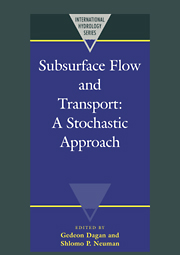Book contents
- Frontmatter
- Contents
- List of contributors
- Preface
- Acknowledgments
- I INTRODUCTION
- II SUBSURFACE CHARACTERIZATION AND PARAMETER ESTIMATION
- III FLOW MODELING AND AQUIFER MANAGEMENT
- IV TRANSPORT IN HETEROGENEOUS AQUIFERS
- V FRACTURED ROCKS AND UNSATURATED SOILS
- 1 Component characterization: an approach to fracture hydrogeology
- 2 Stochastic analysis of solute transport in partially saturated heterogeneous soils
- 3 Field-scale modeling of immiscible organic chemical spills
- VI A VIEW TO THE FUTURE
1 - Component characterization: an approach to fracture hydrogeology
Published online by Cambridge University Press: 04 December 2009
- Frontmatter
- Contents
- List of contributors
- Preface
- Acknowledgments
- I INTRODUCTION
- II SUBSURFACE CHARACTERIZATION AND PARAMETER ESTIMATION
- III FLOW MODELING AND AQUIFER MANAGEMENT
- IV TRANSPORT IN HETEROGENEOUS AQUIFERS
- V FRACTURED ROCKS AND UNSATURATED SOILS
- 1 Component characterization: an approach to fracture hydrogeology
- 2 Stochastic analysis of solute transport in partially saturated heterogeneous soils
- 3 Field-scale modeling of immiscible organic chemical spills
- VI A VIEW TO THE FUTURE
Summary
INTRODUCTION
Within (he last few decades, the problems in hydrogeology and reservoir engineering have changed, from simply being concerned with how much fluid could be extracted or injected, to more complex problems such as contaminant transport and multi-fluid extraction schemes. Engineers began to realize that field-scale observations of these complex phenomena could not be predicted from laboratory measurements. A prime example was that lab-scale measurements of dispersivity were too small to account for the amount of contaminant spreading actually observed in the field. Scientists came to the conclusion that this amount of spreading was due to the heterogeneous nature of the medium and was really advective in nature. The large-scale dispersion was actually the tortuosity of flow as fluids moved through the more permeable parts of the medium and around the less permeable parts. Work began to define the nature of geologic heterogeneity and its effect on flow and transport.
This chapter examines the special nature of fracture heterogeneity and the implications of this nature for system characterization and the development of predictive models for hydrologic behavior. Examples are drawn from work at various sites in different rock types. The philosophy expounded in this chapter is primarily a rationalist approach. That is, the rock type and the history determine the nature of the hydrology. Observations should illuminate this nature and identify the components of the system which affect flow. This conceptual understanding of the system components should then guide further characterization efforts, placing emphasis on measurements made judiciously (rather than randomly or regularly) and based on understanding of the role of the various components of the system.
- Type
- Chapter
- Information
- Subsurface Flow and TransportA Stochastic Approach, pp. 179 - 195Publisher: Cambridge University PressPrint publication year: 1997
- 7
- Cited by



